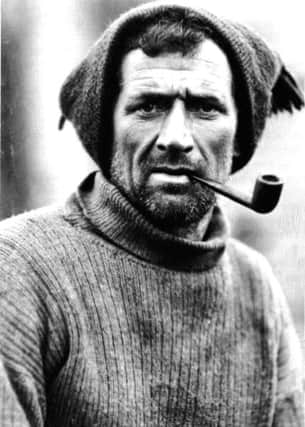Roamer: Irishman's greatest single-handed act of bravery in history of polar exploration


Some, like Inniskilling Dragoon Captain ‘Titus’ Oates,
Ernest Shackleton from Co. Kildare and Banbridge’s Francis Crozier, have to a greater or lesser extent been well documented.
And during the past few weeks Roamer’s page has included short accounts of Vice Admiral Sir Leopold McClintock from Dundalk; Captain Henry Kellet from Tipperary; George Mecham from Cobh, and Captain Robert McClure from Wexford - all polar heroes.
Advertisement
Hide AdAdvertisement
Hide AdI also mentioned in passing Arthur Dobbs from Carrickfergus, the first Irishman to make a significant contribution to Arctic exploration in the 18th century and Edward Bransfield from Ballinacurra, Co. Cork, one of the earliest Irish explorers honoured with his name on a map, and the first explorer to sight mainland Antarctica.
Today’s short account of the extraordinarily courageous (and virtually indestructible!) Tom Crean, from Co. Kerry, will be the last ice-bound biography for the time being. (Unless more polar introductions arrive in Roamer’s mail-box!)
Tom Crean was born on Feb 25, 1877, to Patrick Crean and Catherine, née Courtney, who had a little farm near the Kerry village of Annascaul.
Tom, one of 10 children, left school when he was 12 to help on the farm, but soon decided to go to sea - without his parent’s blessing!
Advertisement
Hide AdAdvertisement
Hide AdAt the age of 15 he enlisted in the Royal Navy and after serving on various vessels became a petty officer around 1899.
It was pure coincidence that his ship, H.M.S Ringarooma, was in Christchurch, New Zealand, at the same time as Captain Scott’s Discovery, and that Scott had a vacancy for a crewman.
In December 1901 Crean joined Discovery as a volunteer Able Seaman.
Scott was impressed with the young Kerry-man during his 1901-1904 expedition and promoted Crean to petty officer (1st Class).
Advertisement
Hide AdAdvertisement
Hide AdTom was one of the first men Scott chose for his doomed expedition to conquer the South Pole
Crean dearly wanted to be in the party to make the final push to the Pole but Scott sent him back to look after the base camp.
Crean was among the last three men to see Scott alive.
Scott and his party reached the South Pole on Thursday, January 18, 1912 only to find that Amundsen’s Norwegian team had got there first on Saturday, December 16, 1911.
The British team’s tragic return journey is now legendary, but Tom Crean’s part in the final days of the expedition is lesser told, as is his epic polar career thereafter.
Advertisement
Hide AdAdvertisement
Hide AdDuring the return journey to base camp in February 1912 Crean performed what is regarded as one of the greatest, single-handed, acts of bravery in the history of Antarctic exploration.
When one of his companions collapsed 35 miles from safety, Crean volunteered to go for help.
It was a treacherous, lonely, trek across hazardous terrain in sub-zero temperatures, blizzards and gales.
Crean only had two small bars of chocolate and three biscuits to eat.
Advertisement
Hide AdAdvertisement
Hide AdHe had no sleeping bag or tent and was physically exhausted after trudging across the desolate ice for three months, covering some 1,500 miles!
His solitary trek lasted 18 hours and earned him the Albert Medal, then the highest gallantry award available.
And in November 1912 he was one of the team sent out to find Scott’s party.
On the afternoon of Friday, November 15, they came across the tent.
Advertisement
Hide AdAdvertisement
Hide AdInside were the stiff, lifeless, frostbitten bodies of Scott, Wilson and Bowers.
Tom Crean wept unashamedly.
He returned to his duties with the Royal Navy, stationed at Chatham, and in 1913 Ernest Shackleton chose him for a proposed crossing of Antarctica.
The expedition never took place as their ship, the Endurance, was crushed in the ice and sank, but Tom was chosen to make the epic open boat crossing of Drake’s Passage from Elephant Island to South Georgia Island in 1916.
Crean helped to sail a tiny boat across the Southern Ocean, the wildest most inhospitable seas on earth.
Advertisement
Hide AdAdvertisement
Hide AdHe then walked 40 miles with his little team over the forbidding, gale-swept mountains, ice flows and glaciers of South Georgia, rescuing 22 comrades left stranded on Elephant Island.
The crossing of the island with Shackleton and another explorer was, and is, regarded as a miraculous undertaking!
It had never been done before, and is still regarded as an ‘impossible journey’, accomplished by only a handful of heroes who took much longer than Crean and Shackleton.
Tom arrived back in England in November 1916 and returned to his Navy duties at Chatham.
Advertisement
Hide AdAdvertisement
Hide AdHe married his childhood sweetheart Nell Herlihy on Wednesday, September 5, 1917 in his hometown of Anascaul.
He was 40 and Nell 36.
They had three daughters, though one sadly died of epilepsy in early childhood.
In 1919, serving on H.M.S Fox, Tom suffered a bad fall which resulted in his early retirement from the navy in 1920 at the age of 42.
In 1927 he achieved one of his lifelong ambitions and opened a pub in Anascaul, called The South Pole Inn!
Advertisement
Hide AdAdvertisement
Hide AdWriter and polar historian Michael Smith, author of Crean’s biography ‘An Unsung Hero’, wrote “it would be impossible to compose a history of Antarctic exploration without recognising and saluting the massive contribution he made.”
Tom Crean died in 1938 aged 61.